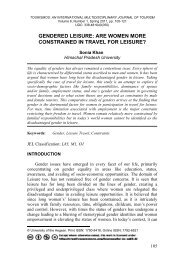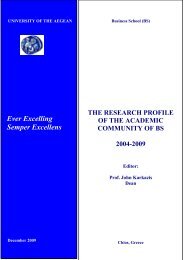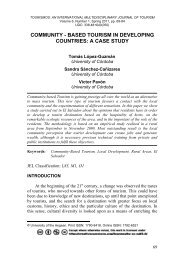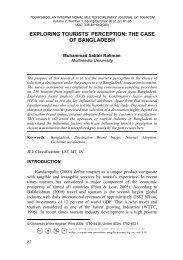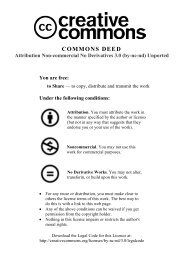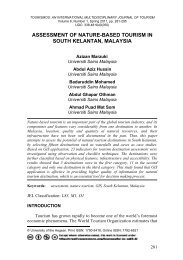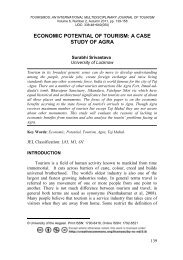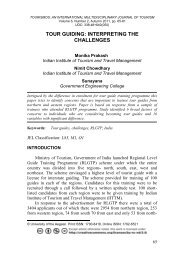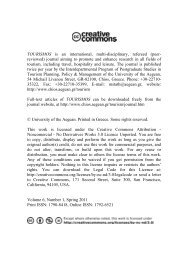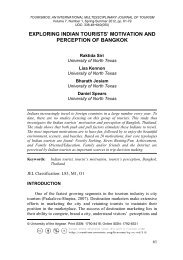is 'malaysia truly asia'? forecasting tourism demand from asean ...
is 'malaysia truly asia'? forecasting tourism demand from asean ...
is 'malaysia truly asia'? forecasting tourism demand from asean ...
You also want an ePaper? Increase the reach of your titles
YUMPU automatically turns print PDFs into web optimized ePapers that Google loves.
TOURISMOS: AN INTERNATIONAL MULTIDISCIPLINARY JOURNAL OF TOURISMVolume 7, Number 1, Spring-Summer 2012, pp. 367-381UDC: 338.48+640(050)(2003); and Kulendran and Witt (2001). The ARIMA model <strong>is</strong> proven tobe reliable in modelling and tour<strong>is</strong>m <strong>demand</strong> <strong>forecasting</strong> with monthlyand quarterly time-series. Wong et al. (2007) used four types of models,namely seasonal auto-regressive integrated moving average model(SARIMA), auto-regressive d<strong>is</strong>tributed lag model (ADLM), errorcorrection model (ECM) and vector-autoregressive model (VAR) toforecast tour<strong>is</strong>m <strong>demand</strong> for Hong Kong by residents <strong>from</strong> ten majororigin countries. The empirical results of the study shows that forecastcombinations do not always outperform the best single forecasts whichhave been used frequently in previous studies. Therefore, combination ofempirical models can reduce the r<strong>is</strong>k of <strong>forecasting</strong> failure in practice. Forexample, Coshall (2009) used univariate time series approach, combiningthe ARIMA, volatility and smoothing models to forecast UnitedKingdom’s <strong>demand</strong> for international tour<strong>is</strong>m. Generally, <strong>from</strong> th<strong>is</strong> studywe can conclude that the ARIMA volatility models tend to overestimate<strong>demand</strong>, and the smoothing models are inclined to underestimate thenumber of future tour<strong>is</strong>t arrivals.Chu (2008a) modified ARIMA modelling to fractionally integratedautoregressive moving average (ARFIMA) in <strong>forecasting</strong> tour<strong>is</strong>m<strong>demand</strong>. Th<strong>is</strong> ARFIMA model <strong>is</strong> ARMA based methods. Three types ofunivariate models were applied in the study with some modification inARMA model to become ARAR and ARFIMA model. The main purposeof th<strong>is</strong> study <strong>is</strong> to investigate the ARMA based models and its usefulnessas a forecast generating mechan<strong>is</strong>m for tour<strong>is</strong>m <strong>demand</strong> for nine majortour<strong>is</strong>t destinations in the Asia-Pacific region. Th<strong>is</strong> study <strong>is</strong> different <strong>from</strong>other tour<strong>is</strong>m <strong>forecasting</strong> studies publ<strong>is</strong>hed earlier, because we canidentify the ARMA based models behaviour and the difference betweenARFIMA models with other ARMA based models. Again, Chu (2008b)studied the ARIMA based model using ARAR algorithm model in orderto analyze and forecast tour<strong>is</strong>m <strong>demand</strong> for Asia-Pacific region usingmonthly and quarterly data. Th<strong>is</strong> study reveals that the performancebetween forecasts generated by monthly and quarterly data <strong>is</strong> similar.Besides <strong>forecasting</strong> tour<strong>is</strong>t arrivals, prediction of tour<strong>is</strong>m revenue can alsobe done using empirical modelling. Akal (2004) used autoregressiveintegrated moving average cause-effect (ARMAX) modelling to forecastinternational tour<strong>is</strong>m <strong>demand</strong> for Turkey. The ARMAX model <strong>is</strong> actuallyderived <strong>from</strong> the ARIMA approaches. The forecast estimations are animportant benchmark for Turkey’s government to strengthen the tour<strong>is</strong>msector in order to transform it into a major contributing sector foreconomic development in the future.369



